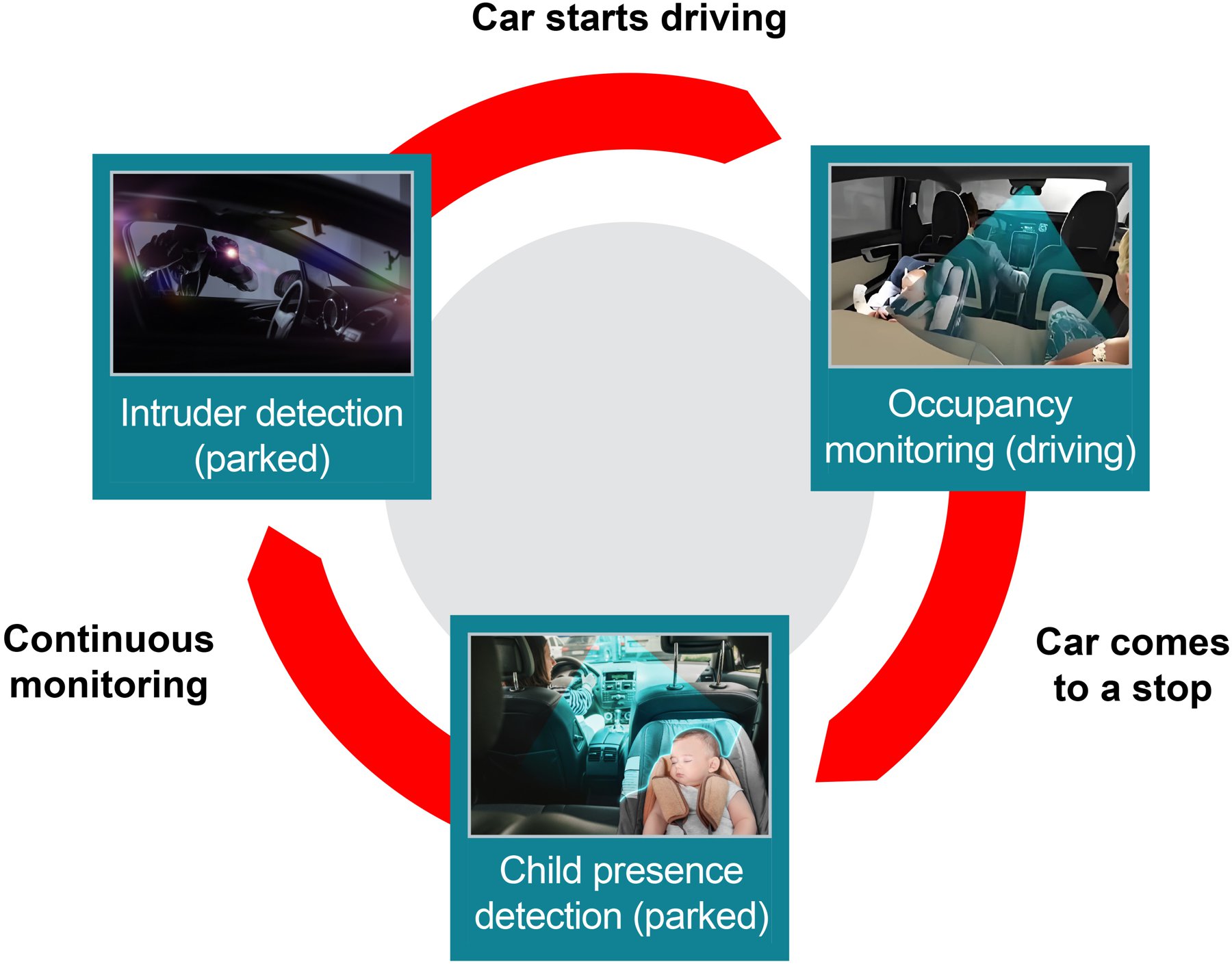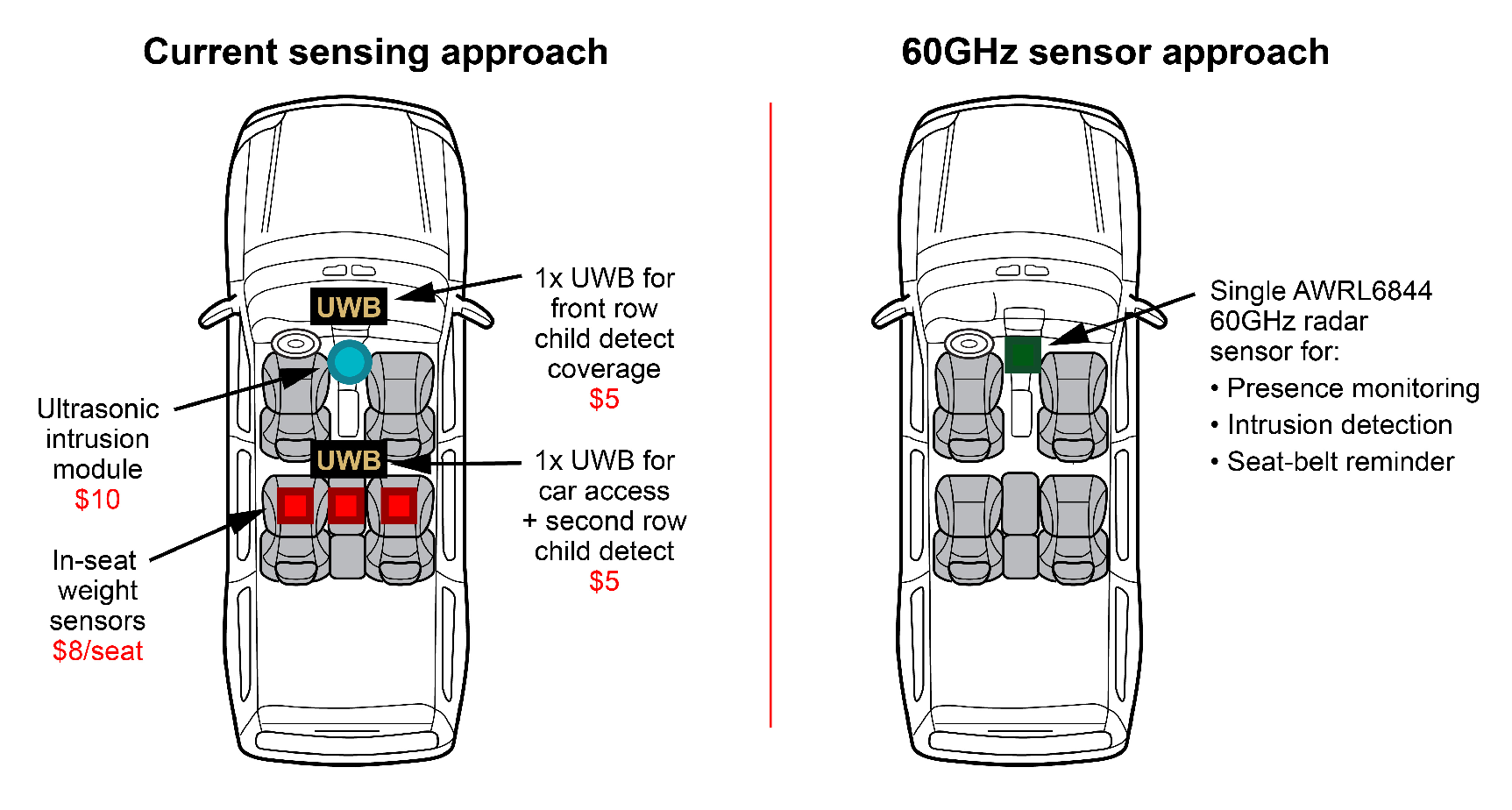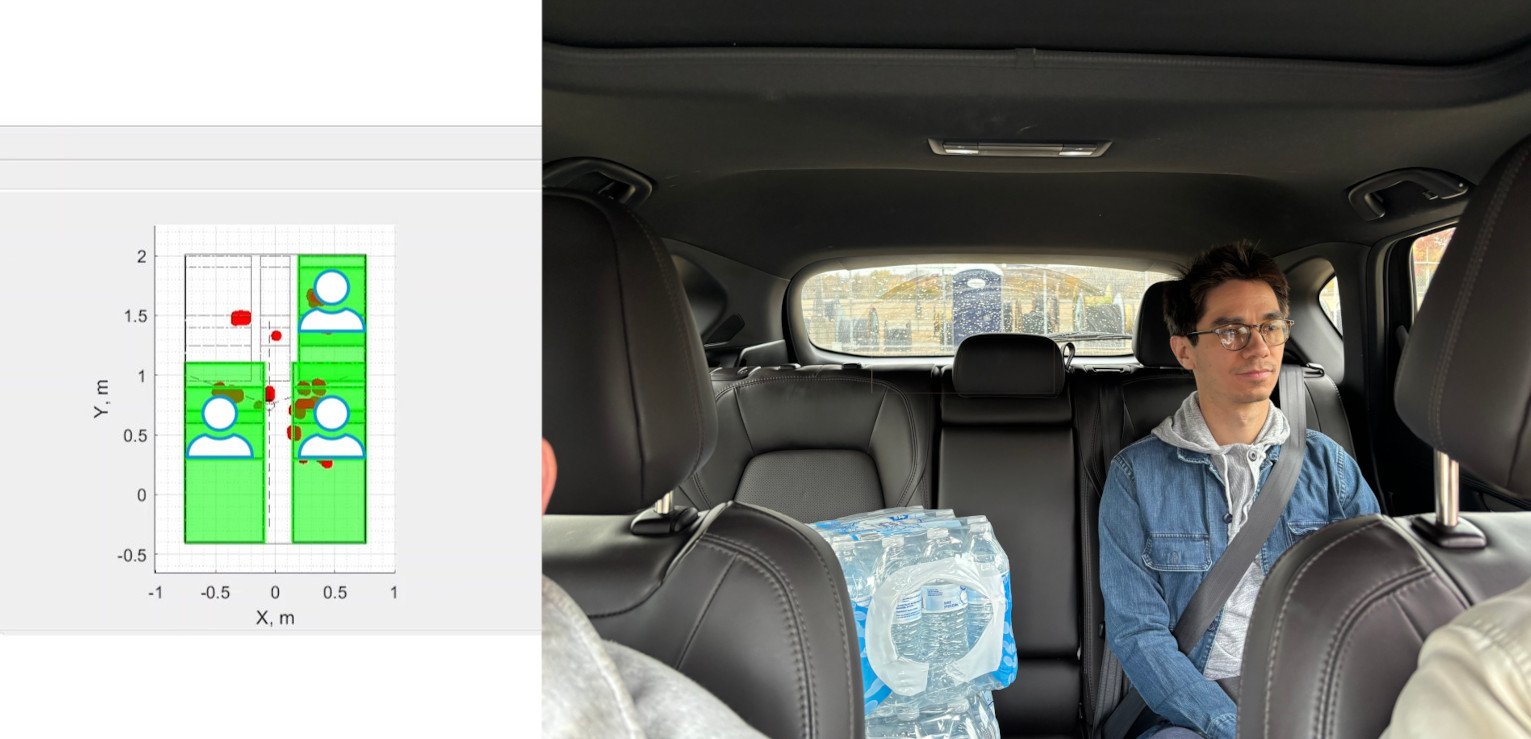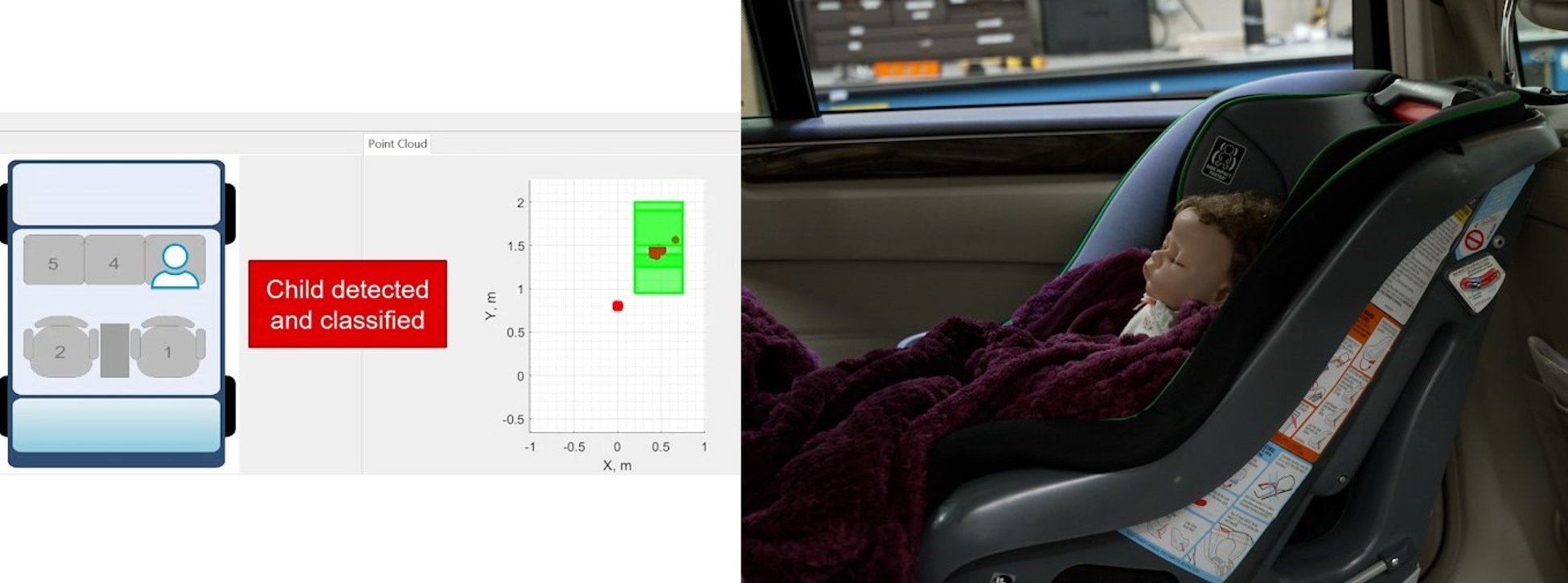SSZTD65 December 2024 AWRL6844
To meet consumer demands for a more comfortable, feature-rich driving experience, original equipment manufacturers (OEMs) are facing a growing challenge: expanding in-cabin safety system sensing capabilities to meet changing regulatory requirements while minimizing design complexity and cost. Upcoming changes to the European New Car Assessment Program (Euro NCAP) and other standards will alter how safety points are awarded to new vehicles, encouraging OEMs to incorporate more sensing capabilities to their vehicles.
Traditionally, expanding in-vehicle sensing applications to support features like occupancy monitoring, child presence detection and intrusion detection required the addition of discrete sensors. However, recent innovations in radar sensor SoCs now support multiple features in a single device through deep learning (edge artificial intelligence [AI]) capabilities. Local processing of in-vehicle data through trained algorithms is helping automotive system designers address complexity and minimize system costs.
In this article, I’ll discuss OEM design challenges, and how edge AI-enabled 60GHz radar sensors help automotive designers solve them.
In-cabin radar design challenges
To address recent design trends and regulatory requirements, OEMs are focusing on three primary in-cabin sensing applications: occupancy monitoring for seat-belt reminders, presence detection (specifically child presence detection) and intrusion detection. These sensing applications are vital to ensuring occupant safety and security throughout the driving journey, as shown in Figure 1.
 Figure 1 In-cabin sensing throughout
the driving journey
Figure 1 In-cabin sensing throughout
the driving journeyThis section discusses each feature, highlighting design challenges OEMs face during design.
- Occupant monitoring for seat-belt reminders: Today, seat-belt reminder systems rely on in-seat meshes of weight sensors, calibrated and tuned to each specific seat. Traditionally, these systems are installed on the front two seats in a car; however, OEMs are now placing sensors in the back rows of vehicles for added safety, and to achieve regulatory compliance. The challenge is that placing sensors in the back rows can more than double the number of sensors in the vehicle and requires additional cabling, as well as calibration and tuning time. Also, weight sensor meshes cannot distinguish between living and inanimate objects such as backpacks and can trigger false occupancy alerts - potentially impacting the driving experience.
- Child presence detection: With Euro NCAP changes in 2025, only direct sensing applications will receive safety points for detecting children in parked vehicles. To meet these standards, OEMs may add extra sensors. It’s possible to reuse an ultra-wideband (UWB) sensor for child presence detection, but achieving the necessary performance requires adding at least one more UWB sensor. Additionally, without high-resolution data, presence detection systems may struggle to discern between children and adults, another future NCAP requirement.
- Intrusion detection: Intrusion detection systems are becoming more common on high-end vehicles. A system certified by Thatcham Research that includes detection of intrusion events typically uses ultrasonic sensors to sense when an intruder is reaching into a vehicle. Nonintrusive movement such as a person walking beside the car or the car shaking from nearby activity can often trigger these simple systems.
Using edge AI to help solve in-vehicle sensing challenges
Because these in-cabin sensing applications have increasingly stringent performance requirements, OEMs are looking for new technologies to reduce costs and simplify design.
The AWRL6844 60GHz mmWave radar sensor was designed to help solve these design challenges with a single device while also cutting system costs by $20. Figure 2 shows a comparison of typical sensor distribution in vehicles and a single-sensor design approach using an AWRL6844. Table 1 shows the average cost per module when implementing multiple in-cabin sensing applications.
 Figure 2 Comparison of current in-cabin
sensing design approaches and a streamlined approach using a single
AWRL6844
Figure 2 Comparison of current in-cabin
sensing design approaches and a streamlined approach using a single
AWRL6844| Module | OEM module |
|---|---|
| UWB module (child presence detection) | $5 |
| Ultrasonic module (intrusion detection) | $10 |
| Weight sensor module (occupancy detection) | $24 (three seats, $8 each) |
The AWRL6844’s 16 virtual channels provide enhanced spatial resolution to detect and localize occupants in the vehicle while it is running. AI processing of high-resolution data helps the radar distinguish between living and nonliving objects. These algorithms compile data over a short time window for reliable detection and localization of occupants more quickly, while also reducing false detections. Intelligent clustering algorithms running on an integrated digital signal processor can also determine the presence of humans in a vehicle with high accuracy by filtering out noise caused by vehicular movement. Figure 3 shows a demonstration of the AWRL6844 differentiating between a passenger and a stack of water bottles in the second-row seats.
 Figure 3 Demonstration of occupancy
localization and recognition of non-living objects using the AWRL6844
Figure 3 Demonstration of occupancy
localization and recognition of non-living objects using the AWRL6844The wide field of view of the AWRL6844 also increases the ability to detect children in footwells and rear-facing car seats, which are typically blind spots in legacy presence detection systems. Child presence detection software uses a hybrid processing approach, where traditional radar processing techniques first extract important information, and local machine learning models use real-time data to establish a classification system discerning between adults and children (example shown in Figure 4). This hybrid approach enables quicker tuning and modifying of the model to incorporate new test cases or requirements, which reduces OEM deployment time. TI’s physics-informed neural networks help systems make more intelligent decisions, resulting in >90% classification accuracy.
 Figure 4 Demonstration of child
presence detection and classification for a baby in a rear-facing car seat using
the AWRL6844
Figure 4 Demonstration of child
presence detection and classification for a baby in a rear-facing car seat using
the AWRL6844For intrusion detection, the AWRL6844’s integrated low-power modes and machine learning value chains help enhance sensing capabilities without draining the battery while the vehicle is off. The AWRL6844 can sense and compute intruder detection events 10 times per second while consuming <50mW. This prevents the battery from draining, which is important given the growing popularity of battery-powered electric vehicles. In addition to being low power, the AWRL6844 minimizes detection time while maintaining high accuracy by running intruder detection processing on the on-chip accelerator, with minimal interruption from other cores on the device. Figure 5 shows the AWRL6844’s ability to filter out noise in the environment to minimize false alerts triggered by the car shaking or motion outside of the vehicle.
 Figure 5 Demonstration of how the
AWRL6844 uses edge AI capabilities to filter out noise to minimize false
alerts
Figure 5 Demonstration of how the
AWRL6844 uses edge AI capabilities to filter out noise to minimize false
alertsConclusion
For OEMs, cost is a constant challenge when meeting strict safety and security requirements. With the AWRL6844, OEMs can scale from low-power to high-performance applications without worrying about the complexities of integrating three separate technologies tailored for single use cases. Superior detection, localization and classification capabilities coupled with improved false detection performance can ultimately lead to a seamless, more convenient experience for consumers.
Additional resources
Trademarks
All trademarks are the property of their respective owners.